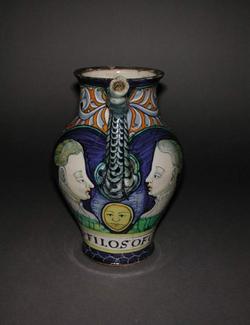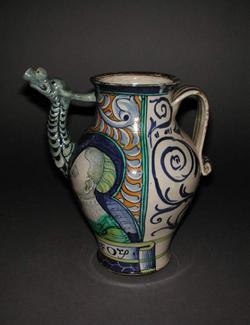Current Location: In storage
Maker(s)
Workshop:
Pompei, Orazio
Entities
Categories
Description
Maiolica spouted pharmacy jar, painted in blue, green, yellow, and orange with profile busts of two young women, and the drug name 'O FILOSOFO' .
Earthenware, tin-glazed except for the base. Painted in blue, green, yellow, and orange. Dragon-spouted baluster jar with strap handle. The spout is surrounded by a truncated heart-shaped panel, enclosing profile busts of two young women facing inwards on either side of an oval yellow mask with a stubbly chin. They have blonde hair and wear green, low-necked dresses with high-necked white chemises. The panel is surrounded by blue and white formal foliage on an orange ground, bordered by vertical green lines edged with blue. The drug name `O FILOSOFO' is inscribed in Roman capitals on a label between yellow horizontal bands which encircle the lower part of the jar. On the back and sides there are large blue spirals, and on the outside of the handle, four vertical blue stripes. The rim is blue with a green horizontal band below. The scales on the spout are blue on a greyish-blue ground.
Notes
History note: A. Wylie; Frederick Leverton Harris (1864-1926)
Legal notes
F. Leverton Harris Bequest
Measurements and weight
Height: 25 cm
Acquisition and important dates
Method of acquisition: Bequeathed
(1927)
by
Harris, Frederick Leverton
Dating
16th Century, third quarter
Renaissance
Circa
1550
CE
-
1560
CE
Note
During the fifteenth and sixteenth centuries many pharmacies in Italian towns were equipped with splendid sets of maiolica jars of different forms with the name of the contents painted on a label which was part of the decoration. Spouted jars were used for oils, and syrups. This one held Philosopher's Oil, which was obtained by distillation of a mixture of powdered brick or tiles and olive oil. It belongs to a group of at least 280 jars of several different forms with closely related and distinctive decoration. The ceramic historian, Bernard Rackham (1876-1964), named them the Orsini-Colonna pharmacy jars after a two-handled bottle in the British Museum decorated with a bear embracing a column, and the words 'ET SARREMO boNI AMICI', emblematic of a reconciliation between these rival Roman families. The Orsini vases might be a more appropriate term. as that family's arms are shown on a two-handled pharmacy jar in the Lehman collection at the Metropolitan Museum of Art in New York, and on a two-handled bottle in a private collection. However, as the number of jars recorded with similar characteristics increased, it became evident that some of the drug names were repeated, two, three, four and in two cases, five times, and that they were therefore likely to have belonged to several sets. This is also indicated by some jars having their labels in Roman capitals, and others in Gothic letters.
In the absence of firm evidence for their origin, the jars used to be attributed to central Italian towns, including Faenza, Deruta, Siena, Cafaggiolo, or Casteldurante. Their secure reattribution of Castelli in the Abruzzi, followed the retrieval of many fragments with similar decoration during an excavation there between 1980 and 1982. This revealed the waste tip on the hillside behind the home of Orazio Pompei (1510-20 to after 1590), a member of a large and flourishing potting family in Castelli. The connection between Orazio and the jars is supported by the inscription 'OC/OPVS/ORATTI' on a dragon-spouted jar in the Museo Internazionale delle Ceramiche at Faenza.
Before the excavation the jars were usually dated to about 1515 to 1530, but given the probable date of Orazio Pompei's birth it seems unlikely that they were made before about 1540, and that production could have continued up to the late 1550s. Some of the female heads are comparable in style to those of the Angel and Madonna in an Annunciation on a panel dated '21.MAI/1557' at Chieti, which suggests that these jars probably date from about 1550 to 1560. Judging by the different styles of representing the male and female heads, and other figures on the jars, they were decorated by more than one member of the Pompei workshop. The decoration closely resembles a jar in the Museo Internazionale delle Ceramiche at Faenza, which is also decorated with two women, has a label written in Roman capitals, but instead of a mask below the spout, has a monogram in a shield.
School or Style
Renaissance
People, subjects and objects depicted
Components of the work
Decoration
composed of
high-temperature colours
( blue, green, yellow, and orange)
Rim
Diameter 10.6 cm
Base
Diameter 9.8 cm
Widest Part
Width 22.5 cm
Body
Materials used in production
Tin-glaze
Earthenware
Techniques used in production
Tin-glazing
Inscription or legends present
- Text: O FILOSOFO
- Location: On lower part of jar
- Method of creation: Painted in Roman capitals
- Type: Label
References and bibliographic entries
Related exhibitions
Identification numbers
Accession number: C.65-1927
Primary reference Number: 75748
Stable URI
Audit data
Created: Saturday 6 August 2011
Updated: Wednesday 20 November 2024
Last processed: Friday 1 August 2025
Associated departments & institutions
Owner or interested party:
The Fitzwilliam Museum
Associated department:
Applied Arts









